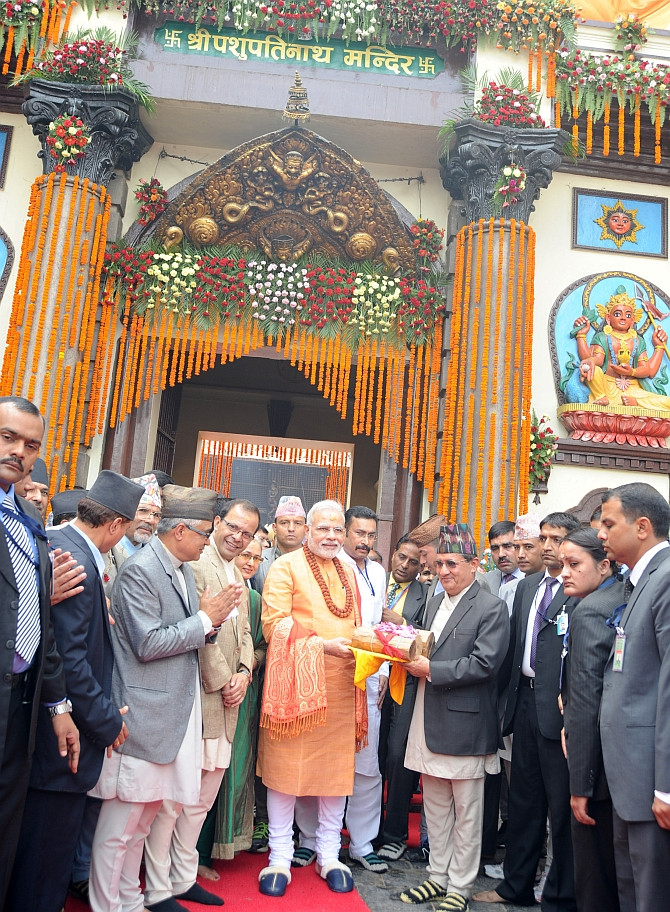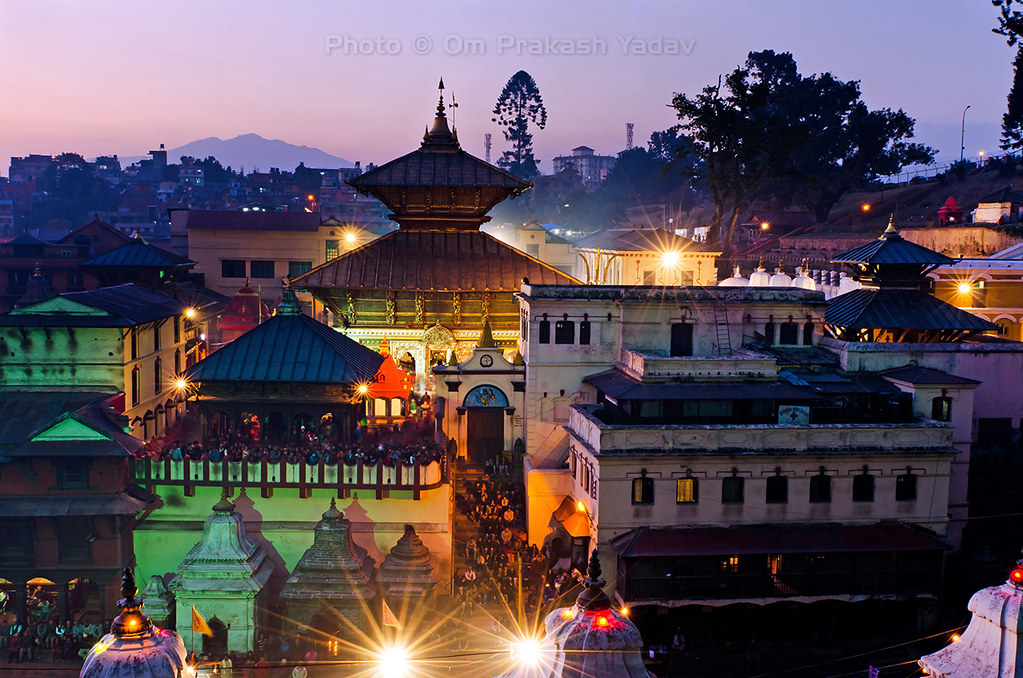The Pashupatinath temple as well as the ‘Pashupat Chhetra’- or the area stretching around the Pashupatinath Temple - is a center of faith and devotion for all followers of Hinduism around the globe.
The Pashupat Chhetra is constituted by a 264-hectare area around Dev Pataan, Jayabageshowri, Gaurighat, Chabahil, Kutmahal, Gaushala, Siphal, Pingalasthan, and the Sleshmantak Forest; encompassing around 492 temples, sprouts, shrines, etc. of various architectural origins and over 1,000 Shiva Lingas.
This area has been called ‘Pashupat Chhetra’ since the Lichhavi era and is home to various sculptures that date back to about 300 B.C. It is the oldest of all religious places in the Kathmandu Valley, making it an open museum of ancient artwork, sculptures, and shrines.
During the daily prayer offerings to Lord Pashupatinath, worship of Shaligram and Shakti also takes place. Similarly, each year, the Budhha Mukut is placed on Lord Pashupatinath. The priest Narayan Prasad Poudel says that all of these together make Lord Pashupatinath the example of religious union. The world heritage site Pashupatinath attracts followers of Hindusim from all around the world in large numbers.
Pashupatinath Darshan
You might have visited Pashupatinath numerous times. Some of you might be planning to visit, but might be unsure about the right procedure to follow. According to the priest Narayan Prasad Poudel, the first thing you need to do is to take a bath and arrive at Pashupatinath with a clean body and clean clothes. Next, you have to leave your slippers/shoes outside and after passing through the security checkpoint, enter the Pashupatinath premises from the west entrance.

The west entrance encloses a Temple to worship the Guru, which is only open on Guru Purnima. First, prayers must be offered at this temple, and only then one must enter inside. The main Bhattas (Priests) of Pashupatinath also offer prayers at the Guru’s temple before entering the inside. After that, the sculptures of Lord Ganesh and Skanda Kumar are to be worshipped. Then, the Shankaracharya Shrine is worshipped. Offerings of Laddu (A kind of sweet) and Dubbo( A kind of grass) are made to Lord Ganesh.
Only after worshipping Changunarayan Temple and the Rudrakaareshwor temple, is one supposed to worship the West entrance of Pashupatinath. Following that, we should offer prayers to Lord Hanuman and Nateshwor respectively. After that, Lord Shiva’s Trishul and Goddess Annapurna should be worshipped.
Then, Chandeshwori, the Sun, Red Lord Ganesh and Basuki should be offered prayers respectively. On worshipping the Baasuki Snake; Mustard seeds, Barley, Curd, Milk, and Honey should be offered. The Basuki Snake’s grand puja is conducted with offerings ranging from 1,100 to Crores of rupees. The devotees who do not wish to host the grand puja may offer smooth Bel Leaves to the Priest.

After the worship of Basuki, the Budhanlkantha on its right and left should be worshipped. Lord Bishnu should be worshipped with Barley and Mustard seeds. Then, the turn for the worship of the east entrance arrives, and simultaneously of Bhrangi and Astha Chiranjivis. The Bagmati River, on whose banks the entire Pashupati Chhetra lies, should then be worshipped. Then, Striyanta and Santanbhareshwor should be offered prayers. This hectic trip finally earns you a break at this point.
Once you reinvigorate your body and spirit, you move on to your next spot – The lord Krishna Temple. At this point, you may break a coconut; this is the only place within the Pashupatinath Premises where you’re allowed to do so. After this, you make a trip to the Bhairav and then to the Shahsra Linga where you offer Bel leaves, Barley, Curd, Milk, Ghee, and Honey.
Nandishwor Hanuman and Nandi are next on your list, after which you do a series of interesting activities. You first take a peek of the main Pashupatinath temple from the south entrance, and move east and take another peek and then take the south toward the east entrance. Then, you worship the Tatpurush and take the right towards the west side.
Now, after worshipping Baamdev at the Northside, you walk down the steps and offer prayers to Lord Pashupatinath from outside the east entrance itself without stepping up the stairs. Then comes the most important bit – Lord Bishnu should be offered prayers while remembering Lord Shiva, then Gajur should be worshipped thinking about the live form of Lord Shiva. On doing this much, the prayers and puja within the Pashupatinath premises are said to be complete.
Especially on full moons and on Shivaratri, this process is believed to grant a lot of blessings. On full moon days, performing worships from dawn till dusk is believed to create a live presence of Lord Shiva himself.
If not doing grand pujas, flowers and unbroken bel leaves can be taken to Basuki and Pashupatinath which shall be administered to the temples by the assistants of the priests. However, only the main priest is allowed to enter the main temple of Pashupatinath for worship. No matter how grand the puja is being conducted, devotees are to worship Lord Pashupatinath from outside.
A special worship ceremony is conducted from 5:30 to 8 P.M. every evening at Pashupatinath. This is also done by the Bhattas ( Priests) there. During this time, all four entrances of the temple are opened. During the month of Poush, this ceremony is administered during night time, which eventually ends only at dawn.
 Nepal
Nepal
 India
India
 Afghanistan
Afghanistan
 Albania
Albania
 Algeria
Algeria
 American Samoa
American Samoa
 Andorra
Andorra
 Angola
Angola
 Anguilla
Anguilla
 Antarctica
Antarctica
 Antigua and Barbuda
Antigua and Barbuda
 Argentina
Argentina
 Armenia
Armenia
 Aruba
Aruba
 Australia
Australia
 Austria
Austria
 Azerbaijan
Azerbaijan
 Bahrain
Bahrain
 Bangladesh
Bangladesh
 Barbados
Barbados
 Belarus
Belarus
 Belgium
Belgium
 Belize
Belize
 Benin
Benin
 Bermuda
Bermuda
 Bhutan
Bhutan
 Bolivia
Bolivia
 Bosnia and Herzegovina
Bosnia and Herzegovina
 Botswana
Botswana
 Brazil
Brazil
 Brunei
Brunei
 Bulgaria
Bulgaria
 Burkina Faso
Burkina Faso
 Burundi
Burundi
 Cambodia
Cambodia
 Cameroon
Cameroon
 Canada
Canada
 Cape Verde
Cape Verde
 Caribbean Netherlands
Caribbean Netherlands
 Cayman Islands
Cayman Islands
 Central African Republic
Central African Republic
 Chad
Chad
 Chile
Chile
 China
China
 Christmas Island
Christmas Island
 Cocos (Keeling) Islands
Cocos (Keeling) Islands
 Colombia
Colombia
 Comoros
Comoros
 Congo, Democratic Republic of the
Congo, Democratic Republic of the
 Congo, Republic of the
Congo, Republic of the
 Cook Islands
Cook Islands
 Costa Rica
Costa Rica
 Cote d Ivoire
Cote d Ivoire
 Croatia
Croatia
 Cuba
Cuba
 Curaçao
Curaçao
 Cyprus
Cyprus
 Czech Republic
Czech Republic
 Denmark
Denmark
 Djibouti
Djibouti
 Dominica
Dominica
 Dominican Republic
Dominican Republic
 East Timor
East Timor
 Ecuador
Ecuador
 Egypt
Egypt
 El Salvador
El Salvador
 Equatorial Guinea
Equatorial Guinea
 Eritrea
Eritrea
 Estonia
Estonia
 Ethiopia
Ethiopia
 Falkland Islands (Malvinas)
Falkland Islands (Malvinas)
 Faroe Islands
Faroe Islands
 Federated States of Micronesia
Federated States of Micronesia
 Fiji
Fiji
 Finland
Finland
 France
France
 French Guiana
French Guiana
 French Polynesia
French Polynesia
 Gabon
Gabon
 Georgia
Georgia
 Germany
Germany
 Ghana
Ghana
 Gibraltar
Gibraltar
 Greece
Greece
 Greenland
Greenland
 Grenada
Grenada
 Guadeloupe
Guadeloupe
 Guam
Guam
 Guatemala
Guatemala
 Guernsey
Guernsey
 Guinea
Guinea
 Guinea-Bissau
Guinea-Bissau
 Guyana
Guyana
 Haiti
Haiti
 Honduras
Honduras
 Hong Kong
Hong Kong
 Hungary
Hungary
 Iceland
Iceland
 Indonesia
Indonesia
 Iran
Iran
 Iraq
Iraq
 Ireland
Ireland
 Isle of Man
Isle of Man
 Israel
Israel
 Italy
Italy
 Jamaica
Jamaica
 Japan
Japan
 Jersey
Jersey
 Jordan
Jordan
 Kazakhstan
Kazakhstan
 Kenya
Kenya
 Kiribati
Kiribati
 Korea, North
Korea, North
 Korea, South
Korea, South
 Kuwait
Kuwait
 Kyrgyz Republic
Kyrgyz Republic
 Kyrgyzstan
Kyrgyzstan
 Laos
Laos
 Latvia
Latvia
 Lebanon
Lebanon
 Lesotho
Lesotho
 Liberia
Liberia
 Libya
Libya
 Liechtenstein
Liechtenstein
 Lithuania
Lithuania
 Luxembourg
Luxembourg
 Macao
Macao
 Macedonia
Macedonia
 Madagascar
Madagascar
 Malawi
Malawi
 Malaysia
Malaysia
 Maldives
Maldives
 Mali
Mali
 Malta
Malta
 Marshall Islands
Marshall Islands
 Martinique
Martinique
 Mauritania
Mauritania
 Mauritius
Mauritius
 Mayotte
Mayotte
 Mexico
Mexico
Moldova
 Monaco
Monaco
 Mongolia
Mongolia
 Montenegro
Montenegro
 Montserrat
Montserrat
 Morocco
Morocco
 Mozambique
Mozambique
 Myanmar (Burma)
Myanmar (Burma)
 Namibia
Namibia
 Nauru
Nauru
 Netherlands
Netherlands
 New Caledonia
New Caledonia
 New Zealand
New Zealand
 Nicaragua
Nicaragua
 Niger
Niger
 Niue
Niue
 Norfolk Island
Norfolk Island
 Northern Mariana Islands
Northern Mariana Islands
 Norway
Norway
 Oman
Oman
 Pakistan
Pakistan
 Palau
Palau
 Palestine
Palestine
 Panama
Panama
 Papua New Guinea
Papua New Guinea
 Paraguay
Paraguay
 Peru
Peru
 Philippines
Philippines
 Poland
Poland
 Portugal
Portugal
 Puerto Rico
Puerto Rico
 Qatar
Qatar
 Reunion
Reunion
 Romania
Romania
 Russia
Russia
 Rwanda
Rwanda
 Saint Barthélemy
Saint Barthélemy
 Saint Kitts and Nevis
Saint Kitts and Nevis
 Saint Lucia
Saint Lucia
 Saint Martin
Saint Martin
 Saint Vincent and the Grenadines
Saint Vincent and the Grenadines
 Samoa
Samoa
 San Marino
San Marino
 Sao Tome and Principe
Sao Tome and Principe
 Saudi Arabia
Saudi Arabia
 Senegal
Senegal
 Serbia and Montenegro
Serbia and Montenegro
 Seychelles
Seychelles
 Sierra Leone
Sierra Leone
 Singapore
Singapore
 Sint Maarten
Sint Maarten
 Slovakia
Slovakia
 Slovenia
Slovenia
 Solomon Islands
Solomon Islands
 Somalia
Somalia
 South Africa
South Africa
 South Sudan
South Sudan
 Spain
Spain
 Sri Lanka
Sri Lanka
 St. Helena
St. Helena
 St. Pierre And Miquelon
St. Pierre And Miquelon
 Sudan
Sudan
 Suriname
Suriname
 Swaziland
Swaziland
 Sweden
Sweden
 Switzerland
Switzerland
 Syria
Syria
 Taiwan
Taiwan
 Tajikistan
Tajikistan
 Tanzania
Tanzania
 Thailand
Thailand
 The Bahamas
The Bahamas
 The Gambia
The Gambia
 Togo
Togo
 Tonga
Tonga
 Trinidad and Tobago
Trinidad and Tobago
 Tunisia
Tunisia
 Turkey
Turkey
 Turkmenistan
Turkmenistan
 Turks and Caicos Islands
Turks and Caicos Islands
 Tuvalu
Tuvalu
 Uganda
Uganda
 Ukraine
Ukraine
 United Arab Emirates
United Arab Emirates
 United Kingdom
United Kingdom
 United States
United States
 Uruguay
Uruguay
 US Minor Outlying Islands
US Minor Outlying Islands
 Uzbekistan
Uzbekistan
 Vanuatu
Vanuatu
 Vatican City (Holy See)
Vatican City (Holy See)
 Venezuela
Venezuela
 Vietnam
Vietnam
 Virgin Islands (British)
Virgin Islands (British)
 Virgin Islands(U.S.)
Virgin Islands(U.S.)
 Wallis and Futuna Islands
Wallis and Futuna Islands
 Western Sahara
Western Sahara
 Yemen
Yemen
 Yugoslavia
Yugoslavia
 Zaire
Zaire
 Zambia
Zambia
 Zimbabwe
Zimbabwe


